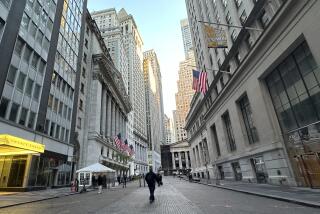Economic Expansion Streak Closing In on U.S. Record
- Share via
The nation’s economy appears to be expanding at a steady, though slightly slowing, pace that should put it on target to produce the longest business expansion in U.S. history, according to two private reports released Wednesday.
The National Assn. of Purchasing Management said the industrial sector expanded for a 10th consecutive month in November, but at a slower rate than in previous months.
The Conference Board, meanwhile, said its index of leading economic indicators--a barometer of economic activity in the next three to six months--was unchanged in October from September.
Wall Street found evidence in the reports that the Federal Reserve’s three interest rate increases this year seemed to have cooled inflationary pressures. The Dow Jones industrial average rose 120.58 points Wednesday to close at 10,998.39.
The economic reports present “a solid and steady picture,” said David Orr, chief economist at the First Union Corp. in Charlotte, N.C.
Stability in economic growth will likely be seen by Fed policymakers as evidence that their previous rate increases have worked, “with nothing to compel them to do anything more at this point,” he said.
The figures indicate that the overall U.S. economic expansion that began in March 1991 should continue through February, to become the longest in U.S. history.
The longest U.S. expansion is 106 consecutive months of growth in the 1960s, a mark that will be reached in January.
The purchasing managers’ index, which tracks the industrial economy, slipped to 56.2 in November from 56.6 in October. That was slightly below analysts’ predictions. Readings over 50, however, indicate growth.
The index, based on a national survey of executives who buy raw materials and other supplies for industry, is watched closely because it is the first measure of November activity in the key manufacturing sector.
The Conference Board’s index of leading economic indicators stood at 107.9 in October, the same as in September and in line with analysts’ expectations.
Ken Goldstein, an economist with the business-financed research group, said in a statement accompanying the report that the pause in the index “centers on weak indicators of manufacturing activity.”
Also Wednesday, the Commerce Department reported that construction spending rose a solid 0.3% in October, largely reflecting a sharp increase in big government projects and a pickup in residential building. It said spending rose to a seasonally adjusted annual rate of $699.3 billion.
(BEGIN TEXT OF INFOBOX / INFOGRAPHIC)
Index of Leading Economic Indicators
Seasonally adjusted index; 1992=100.
October:
107.9
Source: Conference Board
Purchasing Managers Index
Tracks overall business activity of more than 300 industrial companies.November:
56.2%
Source: National Assn. of Purchasing Management
More to Read
Inside the business of entertainment
The Wide Shot brings you news, analysis and insights on everything from streaming wars to production — and what it all means for the future.
You may occasionally receive promotional content from the Los Angeles Times.










